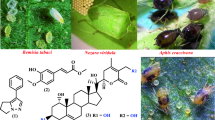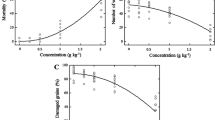Abstract
The edible plant, Piper guineense Schum and Thonn, belongs to the family Piperaceae and possesses insecticidal properties against stored product insects, but information on isolation and use of its amide alkaloids for the control of insect pests is scanty. Therefore, amide alkaloids from P. guineense fruits as well as its crude extract were investigated as protectant against Sitophilus zeamais Motschulschy (Coleoptera: Curculionidae), a cosmopolitan insect pest. Chemical analysis of P. guineense was done using chromatographic techniques and amide alkaloids were identified using liquid chromatography–quadrupole time of flight-mass spectrometry (LC-QToF-MS). The compounds were assayed on five pairs of two-day-old S. zeamais, feeding with the maize variety, TZPB-SR-W. All parameters, including mortality and oviposition by female S. zeamais, repellent effect of the compounds and their effects on maize seed germination, were evaluated relative to the synthetic chemical, pirimiphos-methyl and ethanol, as positive and negative controls, respectively. The six compounds identified were dihydrowisanine (1.01%), guineensine (0.22%), piperine (6.64%), piperlonguminine (0.25%), propiverine (0.16%) and trichostachine (3.80%). Guineensine and piperine caused the highest mortalities (97.5% and 82.5%, respectively) of S. zeamais, which were not significantly different from the mortality (100%) caused by pirimiphos-methyl. In addition, piperine treatment significantly reduced oviposition (0.75 per grain) when compared to ethanol-treated grains (5.00 per grain). There were no significant differences in per cent germination between maize seeds treated with the amide compounds and those included in the control groups (positive and negative controls). Amide alkaloids from P. guineense offer a useful source of biopesticide material for controlling S. zeamais.

Similar content being viewed by others
Data availability
The data sets generated during and/or analysed during the current study are available from the corresponding author on reasonable request.
Code availability
Not applicable.
References
Abbott WS (1925) A method of computing the effectiveness of an insecticide. J Econ Entomol 18:265–267
Addae-Mensah I, Torto FG, Dimonyeka CL, Baxter I, Sanders KM (1977) Novel amide alkaloids from the roots of Piper guineense. Phytochem 16:757–759
Adedire CO (2003) Use of nutmeg, Myristica fragrans (Houtt) powder and oil for the control of cowpea storage bruchid, Callosobruchus maculatus Fabricius. J Plant Dis Prot 109:193–199
Akinbuluma MD, Adepetun MT, Yeye EO (2015) Insecticidal effects of ethanol extracts of Capsicum frutescens and Dennettia tripetala against Sitophilus zeamais Motschulsky on stored maize. Int J Res Agric for 2:1–7
Akinbuluma MD, Ewete FK (2014) Comparative efficacy of extracts from Azadirachta indica, Piper guineense and pirimiphos-methyl against Sitophilus zeamais Motschulsky (Coleoptera: Curculionidae) in stored maize. J Biol Agri and Healthcare 4:327–334
Akinbuluma MD, Ewete FK, Yeye EO (2017) Phytochemical investigations of Piper guineense seed extract and their effects on Sitophilus zeamais (Coleoptera: Curculionidae) on stored maize. J Crop Prot 6:45–52
Akinkurolere RO, Adedire CO, Odeyemi OO (2006) Laboratory evaluation of the toxic properties of forest anchomanes, Anchomanes difformis against pulse beetle, Callosobruchus maculatus (Coleoptera: Chrysomelidae). Insect Sci Appl 13:25–29
Akob CA, Ewete FK (2010) Effect of four mid-altitude maize varieties on oviposition, development and sex ratio of Sitophilus zeamais Motschulsky (Coleoptera: Curculionidae). Afr Entomol 18:253–258
Alfredo A, Conceição F, Rosa C, Richard NB, Maria JS, Rosa EAS (2011) Seasonal effects on bioactive compounds and antioxidant capacity of six economically important Brassica vegetables. Molecules 16:6816–6832
Asawalam EF, Emosairue SO, Ekeleme F, Wokocha R (2007) Efficacy of Piper guineense (Schum & Thonn) seed extract against maize weevil, Sitophilus zeamais (Motschulsky) as influenced by different extraction solvents. Int J Pest Manage 53:1–6
Bahare S, Zainul AZ, Rabin G, Salam AI, Jovana R, Zabta KS, Tariq K, Javad S, Adem O, Elif T, Marco V, Tugba BT, Lianet MF, Miquel M, William NS (2019) Piper Species: a comprehensive review on their phytochemistry, biological activities and applications. Molecules 24(7):1364
Batista-Pereira LG, Castral TC, da Silva MT, Amaral BR, Fernandes JB, Vieira PC, Correa AG (2006) Insecticidal activity of synthetic amides on Spodoptera frugiperda. Z Naturforsch 61:196–202
Chougourou DC, Zoclanclounon YAB, Agossa CH, Sakiti SED, Agbaka A (2016) Efficacy of mixed powders of Piper guineense and Zingiber officinale as maize grain protectants against Sitophilus zeamais Motschulsky (Coleoptera: Curculionidae). Int J Biol Chem Sci 10:1961–1968
Danho M, Alabi T, Haubruge E, Francis F (2015) Oviposition strategy of Sitophilus zeamais Motsch. (Coleoptera: Curculionidae) in relation to conspecific infestation. Afr J Agric Res 10:301–307
Dodson CD, Dyer LA, Searcy J, Wright Z, Letourneau DK (2000) Cenocladamide, a dihydropyridone alkaloid from Piper cenocladum. Phytochem 53:51–54
Dyer LA, Dodson CD, Stireman JO, Tobler MA, Smilanich AM, Fincher RM, Letourneau DK (2003) Synergistic effects of three Piper amides on generalist and specialist herbivores. J Chem Ecol 29(11):2499–2514
Idoko JE, Adesina JM (2012) Evaluation of the powder of Piper guineense and pirimiphos-methly for the control of cowpea beetle Callosobruchus maculatus (F.). J Agric Technol 8:1365–1374
Kaguchia SM, Gitahi SM, Thoruwa CL, Birgen JK, Hassanali A (2018) Bioefficacy of selected plant extracts against Sitophilus zeamais on post-harvest management of Zea mays. J Phytopharmacol 7:384–391
Lale NES, Yusuf BA (2000) Potential of varietal resistance and Piper guineense seed oil to control infestation of stored millet seeds and processed products by Tribolium castaneum (Herbst). J Stored Prod Res 37:63–75
Mbatchou VC, Tchouassi DP, Dickson RA, Annan K, Mensah AY, Amponsah IK, Jacob JW, Cheseto X, Habtemariam S, Baldwyn T (2007) Mosquito larvicidal activity of Cassia tora seed extract and its key anthraquinones aurantio-obtusin and obtusin. Parasites Vectors 10:562. https://doi.org/10.1186/s13071-017-2512-y
McDonald LL, Guy RH, Speirs RD (1970) Preliminary evaluation of new candidate materials as toxicants, repellents and attractants against stored product insect insects. Marketing Research Report, Number 882, Agricultural Research Service, United States Department of Agriculture, Washington, 183 p
Megudu MA, Okrikata E, Dunuwel DM (2020) Management of Sitophilus zeamais Motschulsky (Coleoptera: Curculionidae) using Nigerian raw diatomite. J Appl Sci Environ Manag 24:1663–1669
Muzemu S, Chitamba J, Goto S (2013) Screening of Stored Maize (Zea mays L.) Varieties Grain for Tolerance against Maize Weevil, Sitophilus zeamais (Motsch.). Intl J Plant Res 3:17–22
Nwosu LC, Adedire CO, Ogunwolu EO (2015) Screening for new sources of resistance to Sitophilus zeamais Motschulsky (Coleoptera: Curculionidae) infestation in stored maize genotypes. J Crop Prot 4:277–290
Obeng-Ofori D, Amiteye S (2000) Enhancing the potency of vegetable oils by combining with pirimiphos-methyl for protection of stored cowpea against infestation by Callosobruchus maculatus (FAB). Ethiop J Sci 23:263–272
Oni MO, Ileke KD (2008) Fumigant toxicity of four botanical plant oils on survival, egg laying and progeny development of the dried yam beetle, Dinoderus porcellus (Coleoptera: Bostrichidae). Ibadan J Agric Res 4:31–36
Sarah ON, Adeyinka AA, Babatunji EO (2011) Hepatoprotective effect of Piper guineense aqueous extract against ethanol-induced toxicity in male rats. J Exp Integr Med 2:71–76
Scott IM, Jensen HI, Philogѐne BJR, Arnason JT (2008) A review of Piper spp. (Piperaceae) phytochemistry, insecticidal activity and mode of action. Phytochem Rev 7:65–75
Sofowora A (1993) Medicinal Plants and Traditional Medicine in Africa. Spectrum Books Limited, Ibadan, pp 191–289
Sulaiman GM, Al Sammarrae KW, Adhiah AH, Zucchetti M, Frapolli R (2011) Chemical characterization of Iraqi propolis samples and assessing their antioxidant potentials. Food Chem Toxicol 49:2415–2421
Torto B, Addae-Mensah I, Moreka L (1992) Antifeedant activity of Piper guineense Schum and Thonn. Amides against larvae of the Sorghum stem borer Chilo partellus (Swinhoe). Insect Sc Appl 13:705–708
Wei LL, Hua RM, Li MY, Huang YZ, Li SG, He YJ, Shen ZH (2014) Chemical composition and biological activity of star anise Illicium verum extracts against maize weevil, Sitophilus zeamais adults. J Insect Sci 14(80):21
Acknowledgements
The authors deeply acknowledge Prof. B. Torto of the Behavioural and Chemical Ecology Unit (BCEU) of the International Centre of Insect Physiology and Ecology (ICIPE), Nairobi, Kenya, for granting the permission to carry out this work in his laboratory and for his professional roles. The technical assistance from Mr Onesmus Wanyanma and Mrs Ruth Kihika of BCEU, ICIPE, is also appreciated.
Funding
This work was funded by the Tertiary Education Trust Fund under the Academic Staff Training and Development of the University of Ibadan, Nigeria.
Author information
Authors and Affiliations
Contributions
AMD and FKE designed the research. AMD conducted experiments. OIA guided in chromatographic techniques. AMD analysed data and prepared manuscript. All authors read and approved the manuscripts.
Corresponding author
Ethics declarations
Conflict of interest
There was no conflict of interest among the authors of this work.
Ethics approval
Not applicable.
Consent to participate
Not applicable.
Consent for publication
Not applicable.
Additional information
Publisher's Note
Springer Nature remains neutral with regard to jurisdictional claims in published maps and institutional affiliations.
Rights and permissions
About this article
Cite this article
Akinbuluma, M.D., Ewete, F.K. & Oladosu, I.A. Amide alkaloids from Piper guineense and its crude extract as protectants against Sitophilus zeamais. J Plant Dis Prot 128, 1557–1564 (2021). https://doi.org/10.1007/s41348-021-00518-y
Received:
Accepted:
Published:
Issue Date:
DOI: https://doi.org/10.1007/s41348-021-00518-y




